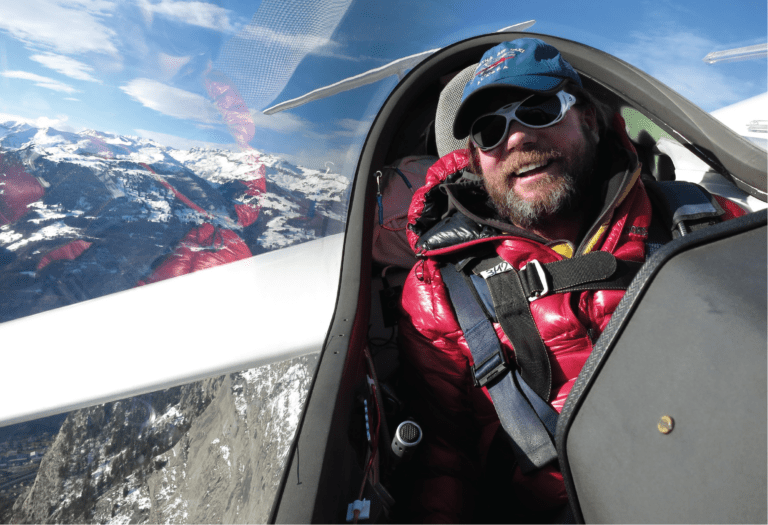Above: Paul Claus
At 24 hours old, Paul Claus took his first flight in a Piper Super Cub. Sixty-five years later, he can still be found soaring across Alaska’s skies, as captivated by wilderness as when he was a child. Whether dropping off mountaineering expeditions or taking guests from his family’s lodge to ski on untouched slopes, Claus sees his airplanes as tools to access Alaska’s wild places.
In a state where about one person out of every hundred is a pilot, Claus has become a legend, a man dedicated to exploring and sharing his remote corner of Alaska.
Claus specializes in true bush flying—no landing strips, no guidebooks, and preferably no one there before him. His daily adventures are classed as experiences of a lifetime in most people’s books, but he believes that he’s just an ordinary guy with the good fortune to do what he loves. And what he loves are big mountains accessed with a pair of wings.
Claus’ reputation as king of Alaska bush pilots has been earned through hard work. Over 35,000 hours in the cockpit have taught him how to become a part of his aircraft. “You have to wear the airplane,” he says. “You have to learn how to feel it. That doesn’t come by reading a book. It doesn’t come by some expert telling you how to do it. It comes by hours and hours of doing it yourself. There’s no exception to that.”
In 1958, Claus’ parents arrived in Alaska on an extended honeymoon, fell in love with the place, and acquired a remote home- stead north of Anchorage. Claus was raised flying between the family’s Anchorage home and homestead. When he was four years old, he started flying with his father on hunting expeditions to the Wrangell Mountains. “My earliest memories are in the back of the Cub with my dad flying all over the state,” Claus says, “but my passion from day one was the Wrangells.”

When Claus was 10 years old, his family obtained five acres on the Chitina River in the middle of nowhere. One hundred miles from the nearest road, their land was perched on the river’s edge with expansive views of the Wrangells. “At about five years old, [I remember] standing on top of the ridge behind what is now our lodge, looking off into the distance and seeing these great big white mountains,” says Claus. “I remember thinking that I could climb those some day.”
Climb them he did. As a kid, Claus pursued two passions: mountains and flying. While his peers were playing football and attending prom, Claus was either in the cockpit or scaling a peak. From an early age, his summers were spent fishing in Bristol Bay with his father, a career he continued for 20 years after school. Though he earned a good income, he dreamed of living on the family’s Chitina property. The question was how to do it.
In 1978, Claus met his wife Donna, a kindred spirit with a love for rugged mountains. Four years later, they moved to the Chitina property, determined to throw everything into creating a life there. They built a luxury lodge and named it Ultima Thule, the classical term for a place beyond the known world. In this home on the edge, they raised and homeschooled three children who are now helping run the lodge.
Today Ultima Thule accommodates 14 guests and provides daily adventures of the most exceptional nature. Guests come from around the world to drink in the scenery, hunt, hike, fish, discover new ski routes, and do first ascents of unclimbed peaks. Every adventure is accessed by airplane. Claus lands on mountain tops, tiny snowfields, glaciers, sand bars, ridges, icy slopes, riverbeds, beaches, you name it.
To Claus, true wilderness is being able to go somewhere no one has been before, to pioneer a new landing, to explore the unknown. His airplanes are a way to access places that otherwise would take days or weeks to reach by foot. “The Super Cub is like a time machine,” he says. “It transports you to places that a hundred years ago were impossible to get to.”

Flying on the job isn’t enough for Claus. After being in the cockpit day in and day out for work, he goes out flying for fun on his days off too. “It’s what he does and what he loves to do,” says Claus’ friend and fellow pilot Don Welty. “It’s not just a job for him. It’s his whole life.”
Claus has become the authority on this type of flying because he embodies the ultimate combination of experience in the cockpit partnered with expertise on the ground. His childhood dream to climb the Wrangells came to fruition through hard work and determination, making Claus into such an accomplished mountaineer that he landed a coveted slot on an Everest expedition that pioneered a new route up the mountain’s West Ridge.
Within the world of aviation, Claus has pushed the envelope of his aircraft’s capabilities. Claus has demonstrated that consistent high-altitude landings are possible; he’s perfected glacier landings with tundra tires, tested equipment, and helped make airplane stronger and safer. He is generous with his time and knowledge.
Claus also cares deeply about protecting wilderness areas. “We have this privilege to explore these wild places here in Alaska and because of that, we also have a responsibility,” he states. “That responsibility is to leave the least amount of impact possible.”
Claus is beginning to wind down his career, spending more time with family and enjoying easy jaunts with guests. “When people tell me I’ve got the best job in the world, I agree,” he laughs. “I hope to keep sharing more of God’s creation and the beautifulness of being out here. This is what I really, really love.”
Emily Mount is a contributing editor at Alaska magazine who lives in southeast Alaska.


Comments are closed.